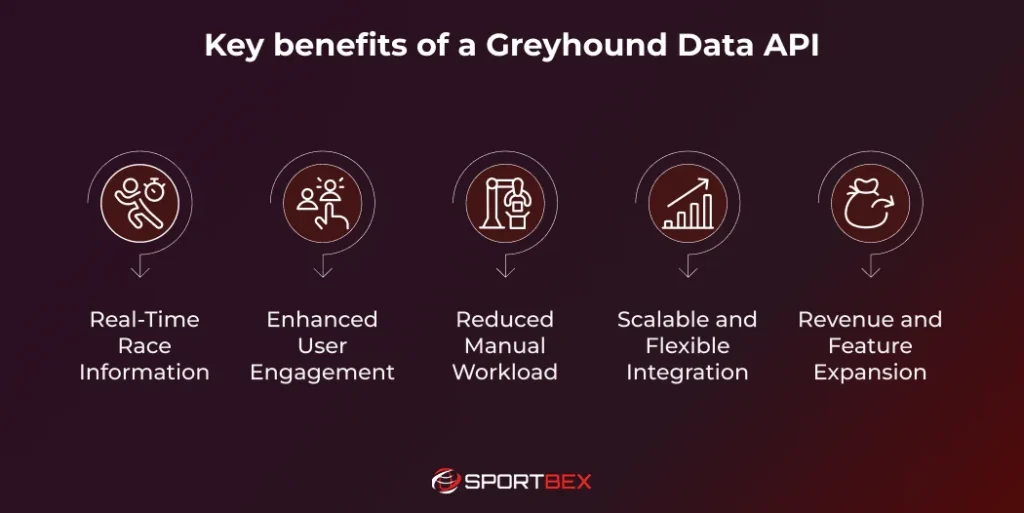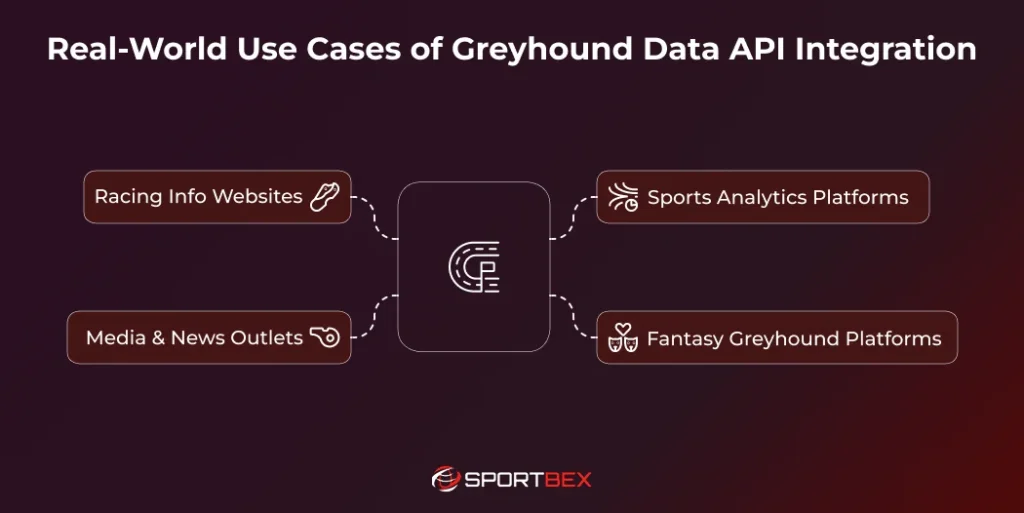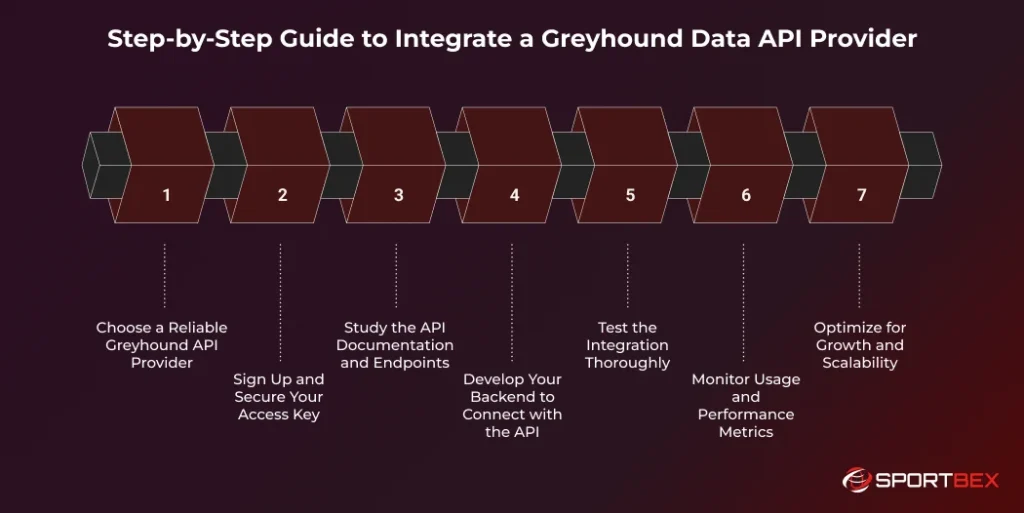In today’s fast-moving sports data ecosystem, integrating a Greyhound Data API into your website is a strategic move to deliver accurate, real-time, and highly engaging race content.
With a reliable Greyhound Stats API provider in place, your platform gains the ability to pull live Greyhound data api, performance statistics, and historical information directly into your system, enabling seamless access to rich, dynamic race insights.
How to Integrate Greyhound Data API into Your Website: By integrating the Greyhound Data API into your website, you can significantly enhance the user experience, creating a responsive, interactive environment where fans and followers can easily access up-to-date race information anytime.
Whether your audience consists of casual race fans or dedicated enthusiasts, a well-integrated data solution strengthens your platform’s performance, reliability, and competitive edge.
What is a Greyhound data API?
A racing data API is a powerful digital solution that provides real-time, structured information on competitive dog racing. It allows developers and platforms to seamlessly access essential data such as race schedules, participant profiles, live results, odds, and track information through easy API integration.
At its core, the API acts as a bridge between race databases and digital platforms, enabling the automatic delivery of both live and historical race content to enhance user experience and engagement.
By integrating live race data, the platform can enhance user experience through real-time leaderboards and advanced analytics features.
Many APIs, including the Greyhound Performance API, provide filters by race ID, location, date, or individual participant, allowing for precise and efficient data access.
Key benefits of a Greyhound Data API

In the evolving world of digital platforms, delivering timely, accurate, and detailed content is no longer optional—it’s expected. For platforms focused on dog racing content, integrating a real-time data solution is one of the most effective ways to meet these expectations.
1. Real-Time Race Information
One of the most significant benefits of using a data API is access to live event updates.
This ensures your users stay informed as events unfold. Whether it’s daily competitions or major tournaments, using a Greyhound Racing API for live updates helps engage audiences and create an immersive user experience.
These APIs deliver real-time information directly from venues, including start times, results, placements, timings, and track details.
2. Enhanced User Engagement
Fans seek more than just scores; they’re looking for context, analysis, and performance history. By integrating a reliable data solution, you can provide detailed profiles of each dog, including historical stats like number of wins, average speeds, past injuries, and more, all within a single, seamless experience powered by the Greyhound Data API.
This level of detail allows fans and analysts to engage deeply with the sport, compare dogs, and follow their favorites more closely.
You can also build features such as predictive analytics, form guides, and performance comparisons to give users the insights they’re looking for. A rich, data-driven interface increases session time, return visits, and overall platform satisfaction.
3. Reduced Manual Workload
Manually collecting race data from multiple sources can be time-consuming, inconsistent, and error-prone. A dedicated data API automates this process, saving your team time and resources.
Once integrated, the API continually pulls the most current data, ensuring your platform remains up to date with minimal human intervention.
This efficiency allows your team to focus on improving user experience, adding new features, and scaling your platform. The reliability of machine-driven updates also reduces the risk of data discrepancies or outdated content, ensuring a smoother operation overall.
4. Scalable and Flexible Integration
These systems are designed to scale effortlessly, whether you’re managing a small fan blog or a full-featured platform.
Most solutions offer custom filtering by event ID, location, date, or participant name, so you can deliver only the most relevant content to your audience. As your platform grows, the infrastructure can handle higher traffic and increased data requests without compromising on speed or performance.
This flexibility is especially valuable during high-profile competitions or when expanding to cover international racing events.
5. Revenue and Feature Expansion
Integrating a data solution not only enhances platform functionality but also opens up valuable monetization opportunities.
Moreover, this integration can serve as the foundation for innovative tools such as race predictors, performance heatmaps, or mobile apps tailored for enthusiasts, making this Greyhound Betting Guide even more valuable for bettors seeking data-driven insights.
Moreover, this integration can serve as the foundation for innovative tools such as race predictors, performance heatmaps, or mobile apps tailored for enthusiasts. With reliable, structured data at your disposal, your platform is well-positioned to test new ideas and scale strategically.
Real-World Use Cases of Greyhound Data API Integration

Ever wonder how real-time race information can add value to your platform? Here’s how this powerful tool is being used across various digital solutions.
1. Racing Info Websites
Websites focused on race events rely on data APIs to deliver real-time schedules, results, and participant statistics.
These platforms use APIs to automatically update content with live race outcomes, ensuring accuracy and immediacy for their visitors.
2. Sports Analytics Platforms
Advanced analytics tools utilize the Sports Data API to pull detailed performance stats, win-loss ratios, and historical data on individual dogs and tracks.
This supports predictive modeling, performance trends, and visualizations that help users dive deeper into analysis.
3. Fantasy Greyhound Platforms
Emerging Fantasy Sports API uses race data APIs to supply participants with accurate stats, form guides, and insights for team selections.
Real-time data ensures a fair and competitive fantasy experience.
4. Media & News Outlets
Race-focused news portals use APIs to fetch real-time results and publish breaking updates.
This automation helps media sites remain timely and error-free.
Step-by-Step Guide to Integrate a Greyhound Data API Provider

Integrating a race data solution into your platform can unlock a world of real-time information, performance stats, historical data, and more.
Whether you’re building a racing website, analytics dashboard, or mobile app, integrating the best Greyhound Racing APIs ensures accurate and dynamic content delivery.
Step 1: Choose a Reliable Greyhound API Provider
The first step is to select an API provider that matches your platform’s requirements. Not all APIs offer the same level of data depth, reliability, or support. Look for features such as:
- Real-time race results
- Dog performance history and profiles
- Track details and past race archives
- Customizable endpoints and filters
Providers like Sportbex are known for their robust datasets and developer-friendly tools, making integration easier for both small projects and enterprise platforms.
Step 2: Sign Up and Secure Your Access Key
After choosing your provider, create an account on their platform. This typically involves filling out a short registration form with your email, business name, and intended use.
Upon registration, you’ll receive an API key, a secure token that authorizes your requests. Keep this key private and secure, as it grants access to the data and is tied to your usage limits or subscription plan.
Step 3: Study the API Documentation and Endpoints
Before writing code, review the API documentation thoroughly. The docs will include:
- Authentication method (usually via HTTP headers)
- Available endpoints like /reces, /dogs, /results
- Query parameters (e.g., race ID, location, or date range)
- Sample requests and response formats (often in JSON)
- Common error messages and solutions
Understanding these details will help you make accurate requests and avoid common mistakes during development.
Greyhound Racing Data, Made Simple
Easily add live race results and dog profiles to your website or project.
Step 4: Develop Your Backend to Connect with the API
Now it’s time to implement the API into your backend system. Depending on your technology stack (like Node.js, Python, PHP), write code to:
- Authenticate using your API key
- Send GET requests to fetch relevant race data.
- Parse the response and extract the needed information
- Store or display the data on your platform
For example, you might retrieve today’s race schedule, format the times, and show dog stats next to each event.
Step 5: Test the Integration Thoroughly
After setting up the connection, conduct end-to-end testing to ensure everything works properly. Check that:
- All endpoints return valid responses
- Race results and participant profiles are accurate and timely.
- Data is formatted and displayed correctly across your UI
- The system handles empty, delayed, or error responses gracefully
Be sure to simulate various scenarios, such as upcoming races, completed races, and invalid IDs, to confirm the integration is stable.
Step 6: Monitor Usage and Performance Metrics
Once your race data integration is live, continuous monitoring is essential to ensure consistent performance and reliability across your platform.
essential, especially for a Sports Betting Website, where accuracy and speed are critical. Use built-in dashboards or third-party monitoring tools to track:
- API request volume
- Response times and latency
- Error logs or failed calls
- Usage limits and API key status
For sports betting platforms, even slight data delays or errors can impact the user experience and trust.
Regular monitoring helps you catch and resolve issues quickly, ensuring your platform delivers timely, reliable race data that bettors can depend on during live events.
Step 7: Optimize for Growth and Scalability
As your platform grows, optimize how you use the API to manage performance and cost. Best practices include:
- Caching frequently used data (like participant bios or race venues)
- Using pagination for large data sets
- Reducing unnecessary calls with more targeted queries
Scalable API design means you can confidently serve thousands of users without bottlenecks or data lags.
Why Should You Choose Sportbex Greyhound Data API?
Sportbex offers a powerful solution tailored for platforms that require fast, reliable, and in-depth access to real-time race information and performance insights.
- Extensive Coverage: Access detailed race schedules, live results, dog profiles, past performance stats, and track information from global events for live stream sports, all through one API.
- Real-Time Accuracy: With ultra-fast data delivery and low latency, Sportbex ensures users receive live race updates and results the moment they happen.
- Developer-Friendly: Sportbex offers clean API documentation, helpful code samples, and responsive support to simplify integration, even for first-time users.
- Flexible Testing: Get started with a free trial to explore the full feature set and test compatibility with your project before committing to a subscription.
Conclusion
Integrating a Sportbex Greyhound Data API might seem technical at first, but it’s a powerful upgrade that brings real-time, structured race data directly to your platform.
With reliable APIs like the Greyhound Stats API, Greyhound Performance API, and Greyhound Track API, you can offer live race results, dog profiles, historical stats, and tools for Greyhound Racing Odds, all in one seamless experience.
This not only improves user engagement but also positions your platform as a trusted source for accurate and timely data.
Live Data from Top Greyhound Tracks
Integrate the fastest, most reliable live odds and race data into your platform.
Frequently Asked Questions
A race data solution provides real-time, well-organized information—ideal for platforms, dashboards, and media services that require live event updates.
This solution is ideal for sports platforms, analytics dashboards, media websites, and developers looking to deliver up-to-date race data to their users.
A fast, reliable provider offering low-latency race data, detailed stats, and easy integration for platforms needing real-time insights.
The API delivers data on upcoming races, results, performance history, timing, placements, and track information—all in a structured and accessible format.
This provider combines speed, data depth, and ease of use. With low-latency updates, comprehensive documentation, and responsive support, it’s a top choice for any platform requiring reliable race data.
Recent Blog
Top Benefits of Basketball Betting Odds for Betting Platform
December 12, 2025
 9 min
9 min
How to Use Greyhound Racing Data to Create Performance Insights
December 11, 2025
 9 min
9 min







